Ramsar Convention
This article includes a list of general references, but it remains largely unverified because it lacks sufficient corresponding inline citations. (October 2017) |
| Ramsar Convention on Wetlands of International Importance Especially as Waterfowl Habitat | |
|---|---|
 Ramsar logo | |
| Signed | 2 February 1971 |
| Location | Ramsar, Iran |
| Effective | 21 December 1975 |
| Condition | Ratification by 7 states |
| Signatories | See list |
| Parties | 171[1] |
| Depositary | Director General of UNESCO |
| Languages | English, French, Spanish, and Persian |
The Ramsar Convention on Wetlands of International Importance Especially as Waterfowl Habitat is an international treaty for the conservation and sustainable use of wetlands.[2] It is also known as the Convention on Wetlands. It is named after the city of Ramsar in Iran, where the convention was signed in 1971.
Every three years, representatives of the contracting parties meet as the Conference of the Contracting Parties (COP), the policy-making organ of the convention which adopts decisions (resolutions and recommendations) to administer the work of the convention and improve the way in which the parties are able to implement its objectives.[3] COP12 was held in Punta del Este, Uruguay, in 2015. COP13 was held in Dubai, United Arab Emirates, in October 2018.
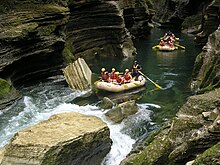
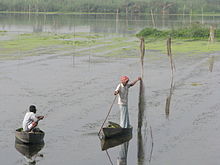
List of wetlands of international importance[]
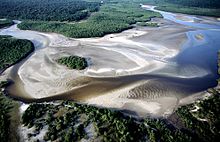
The list of wetlands of international importance included 2,331 Ramsar sites in May 2018 covering over 2.1 million square kilometres (810,000 sq mi). The countries with most sites are the United Kingdom with 175 and Mexico with 142. And, the country with the greatest area of listed wetlands is Bolivia, with around 148,000 square kilometres (57,000 sq mi).[4]
The Ramsar Sites Information Service (RSIS) is a searchable database which provides information on each Ramsar site.[5]
International cooperation[]

As of 2016 there are 18 transboundary Ramsar sites, and 15 Ramsar regional initiatives covering regions of the Mediterranean, Asia, Africa, and South America.
International organization partners[]
The Ramsar Convention works closely with six other organisations known as international organization partners (IOPs). These are:
- BirdLife International
- International Union for Conservation of Nature (IUCN)
- International Water Management Institute (IWMI)
- Wetlands International
- WWF International
- Wildfowl & Wetlands Trust (WWT)
These organizations support the work of the convention by providing expert technical advice, helping implement field studies, and providing financial support. The IOPs also participate regularly as observers in all meetings of the conference of the parties and as full members of the Scientific and Technical Review Panel.
Other partners[]
The convention collaborates with a network of partners:
- Biodiversity-related conventions including the Convention on Biological Diversity (CBD), the Convention to Combat Desertification (UNCCD), Convention on Migratory Species (CMS), the World Heritage Convention (WHC), and the Convention on International Trade in Endangered Species (CITES);
- Project funding bodies including global environmental funds, multilateral development banks and bilateral donors;
- UN agencies such as UNEP, UNDP, UNESCO, and the UN Economic Commission for Europe, and specific programmes such as UNESCO's Man and the Biosphere Programme (MAB);
- Non-governmental organizations including the Nature Conservancy, Conservation International, the Society of Wetland Scientists, the International Association for Impact Assessment, and many others;
- Since 1998 the convention has also benefited from a strong partnership with Danone including the brand, and since 2007 from the Biosphere Connections partnership with the Star Alliance airline network.
Bodies established by the convention[]
Conference of the Contracting Parties[]
This is the convention's governing body consisting of all governments that have ratified the treaty. This ultimate authority reviews progress under the convention, identifies new priorities, and sets work plans for members. The COP can also make amendments to the convention, create expert advisory bodies, review progress reports by member nations, and collaborate with other international organizations and agreements.
The Standing Committee[]
The Standing Committee is the intersessional executive body which represents the COP between its triennial meetings, within the framework of the decisions made by the COP. The contracting parties that are members of the Standing Committee are elected by each meeting of the COP to serve for the three years.
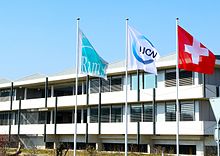
The Scientific and Technical Review Panel[]
The Scientific and Technical Review Panel (STRP) provides scientific and technical guidance to the Conference of Contracting Parties, the Standing Committee, and the Ramsar Secretariat.
The Secretariat[]
The Secretariat carries out the day-to-day coordination of the convention's activities. It is based at the headquarters of the International Union for Conservation of Nature (IUCN) in Gland, Switzerland.
The implementation of the Ramsar Convention is a continuing partnership between the Conference of Contracting Parties, the Standing Committee, and the Secretariat, with the advice of the subsidiary expert body, the Scientific and Technical Review Panel (STRP), and the support of the international organization partners (IOPs).
Martha Rojas Urrego is the sixth secretary general of the Ramsar Convention on Wetlands.
World Wetlands Day[]
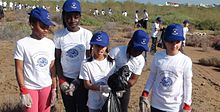
February 2 is World Wetlands Day, marking the convention's adoption on 2 February 1971. Established to raise awareness about the value of wetlands for humanity and the planet, WWD was celebrated for the first time in 1997, and has grown remarkably since then. In 2015 World Wetlands Day was celebrated in 59 countries.
History[]
The convention was co-founded by Eskandar Firouz (former environment minister of Iran), Luc Hoffmann of Tour du Valat research station in the Camargue in France, and Geoffrey Matthews of the Wildfowl & Wetlands Trust at Slimbridge in the late 1960s. The conference which adopted the terms of the agreement was held in the Iranian Caspian Sea resort of Ramsar on 2 February 1971.[6]
See also[]
- Ramsar classification system
- Montreux Record - threat classification for wetlands
- Ramsar Wetland Conservation Award
- List of international environmental agreements
- World Heritage Site - international agreement on historic site recognition
References[]
- ^ "Convention on Wetlands of International Importance especially as Waterfowl Habitat. Ramsar, 2 February 1971". Archived from the original on February 3, 2020.
- ^ "The Ramsar Convention and its Mission". Archived from the original on 9 April 2016. Retrieved 11 October 2016.
- ^ "The Conference of the Contracting Parties". Ramsar. Retrieved 31 March 2019.
- ^ "Ramsar Sites Around the World".
- ^ "Using the Ramsar Sites Information Service"
- ^ "Sad news: death of Mr Eskandar Firouz – Call of the Curlew". curlewcall.org. Retrieved 2020-03-18.
External links[]
| Wikimedia Commons has media related to Ramsar Convention. |
- Ramsar Convention
- Environmental treaties
- UNESCO treaties
- Treaties concluded in 1971
- Treaties entered into force in 1975
- 1971 in the environment
- 1975 in the environment
- 1971 in Iran
- Wetland conservation
- Wildlife law
- Treaties of Albania
- Treaties of Algeria
- Treaties of Andorra
- Treaties of Antigua and Barbuda
- Treaties of Argentina
- Treaties of Armenia
- Treaties of Australia
- Treaties of Austria
- Treaties of Azerbaijan
- Treaties of the Bahamas
- Treaties of Bahrain
- Treaties of Bangladesh
- Treaties of Barbados
- Treaties of Belarus
- Treaties of Belgium
- Treaties of Belize
- Treaties of Benin
- Treaties of Bhutan
- Treaties of Bolivia
- Treaties of Bosnia and Herzegovina
- Treaties of Botswana
- Treaties of Brazil
- Treaties of the People's Republic of Bulgaria
- Treaties of Burkina Faso
- Treaties of Burundi
- Treaties of Cambodia
- Treaties of Cameroon
- Treaties of Canada
- Treaties of Cape Verde
- Treaties of the Central African Republic
- Treaties of Chad
- Treaties of Chile
- Treaties of the People's Republic of China
- Treaties of Colombia
- Treaties of the Comoros
- Treaties of the Republic of the Congo
- Treaties of Croatia
- Treaties of Cuba
- Treaties of Cyprus
- Treaties of the Czech Republic
- Treaties of Denmark
- Treaties of Djibouti
- Treaties of the Dominican Republic
- Treaties of Ecuador
- Treaties of Egypt
- Treaties of El Salvador
- Treaties of Equatorial Guinea
- Treaties of Estonia
- Treaties of Fiji
- Treaties of Finland
- Treaties of France
- Treaties of Gabon
- Treaties of the Gambia
- Treaties of Georgia (country)
- Treaties of Ghana
- Treaties of Greece
- Treaties of Grenada
- Treaties of Guatemala
- Treaties of Guinea
- Treaties of Guinea-Bissau
- Treaties of Honduras
- Treaties of the Hungarian People's Republic
- Treaties of Iceland
- Treaties of India
- Treaties of Indonesia
- Treaties of Iraq
- Treaties of Ireland
- Treaties of Israel
- Treaties of Italy
- Treaties of Ivory Coast
- Treaties of Jamaica
- Treaties of Japan
- Treaties of Jordan
- Treaties of Kazakhstan
- Treaties of Kenya
- Treaties of Kiribati
- Treaties of Kuwait
- Treaties of Kyrgyzstan
- Treaties of Laos
- Treaties of Latvia
- Treaties of Lebanon
- Treaties of Lesotho
- Treaties of Liberia
- Treaties of the Libyan Arab Jamahiriya
- Treaties of Liechtenstein
- Treaties of Lithuania
- Treaties of Luxembourg
- Treaties of North Macedonia
- Treaties of Madagascar
- Treaties of Malawi
- Treaties of Malaysia
- Treaties of Mali
- Treaties of Malta
- Treaties of the Marshall Islands
- Treaties of Mauritania
- Treaties of Mauritius
- Treaties of Mexico
- Treaties of Moldova
- Treaties of Monaco
- Treaties of Mongolia
- Treaties of Montenegro
- Treaties of Morocco
- Treaties of Mozambique
- Treaties of Myanmar
- Treaties of Namibia
- Treaties of Nepal
- Treaties of the Netherlands
- Treaties of New Zealand
- Treaties of Nicaragua
- Treaties of Niger
- Treaties of Nigeria
- Treaties of North Korea
- Treaties of Norway
- Treaties of Oman
- Treaties of Pahlavi Iran
- Treaties of Pakistan
- Treaties of Palau
- Treaties of Panama
- Treaties of Papua New Guinea
- Treaties of Paraguay
- Treaties of Peru
- Treaties of the Philippines
- Treaties of the Polish People's Republic
- Treaties of Portugal
- Treaties of Romania
- Treaties of the Soviet Union
- Treaties of Rwanda
- Treaties of Saint Lucia
- Treaties of Samoa
- Treaties of São Tomé and Príncipe
- Treaties of Senegal
- Treaties of Serbia and Montenegro
- Treaties of Seychelles
- Treaties of Sierra Leone
- Treaties of Slovakia
- Treaties of Slovenia
- Treaties of South Africa
- Treaties of South Korea
- Treaties of South Sudan
- Treaties of Spain
- Treaties of Sri Lanka
- Treaties of the Republic of the Sudan (1985–2011)
- Treaties of Suriname
- Treaties of Eswatini
- Treaties of Sweden
- Treaties of Switzerland
- Treaties of Syria
- Treaties of Tajikistan
- Treaties of Tanzania
- Treaties of Thailand
- Treaties of Togo
- Treaties of Trinidad and Tobago
- Treaties of Tunisia
- Treaties of Turkey
- Treaties of Turkmenistan
- Treaties of Uganda
- Treaties of Ukraine
- Treaties of the United Arab Emirates
- Treaties of the United Kingdom
- Treaties of the United States
- Treaties of Uruguay
- Treaties of Uzbekistan
- Treaties of Venezuela
- Treaties of Vietnam
- Treaties of West Germany
- Treaties of Yemen
- Treaties of Zaire
- Treaties of Zambia
- Treaties of Zimbabwe
- Treaties extended to Akrotiri and Dhekelia
- Treaties extended to Aruba
- Treaties extended to Bermuda
- Treaties extended to British Antigua and Barbuda
- Treaties extended to British Honduras
- Treaties extended to British Hong Kong
- Treaties extended to the British Indian Ocean Territory
- Treaties extended to the British Solomon Islands
- Treaties extended to Brunei (protectorate)
- Treaties extended to the Cayman Islands
- Treaties extended to the Cook Islands
- Treaties extended to the Falkland Islands
- Treaties extended to the Faroe Islands
- Treaties extended to Gibraltar
- Treaties extended to Greenland
- Treaties extended to Guernsey
- Treaties extended to Jersey
- Treaties extended to Montserrat
- Treaties extended to the Netherlands Antilles
- Treaties extended to Niue
- Treaties extended to the Pitcairn Islands
- Treaties extended to Saint Helena, Ascension and Tristan da Cunha
- Treaties extended to Tokelau
- Treaties extended to the Turks and Caicos Islands
- Treaties extended to West Berlin

